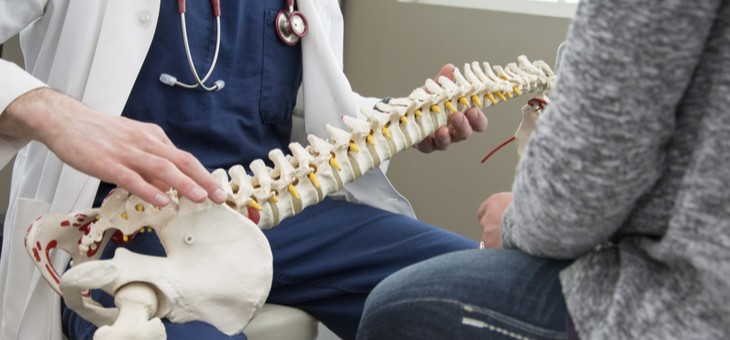Between 60 and 80 per cent of people experience lower back pain at some stage in their lives, which may be caused by serious conditions. While its importance can’t be overstated, many people may be harming their spine without even realising it.
Your spine is made up of 24 vertebrae. These create a protected channel that holds your spinal cord, the highway of nerves that connects your brain to your body. Intervertebral discs are flat, flexible discs that sit between your vertebrae. These absorb shock when you walk, run and jump, cushioning and protecting the bones in your spine.
These six conditions may be endangering your spine.
Slipped disc
Also known as a bulging, ruptured, protruding or herniated disc, a slipped disc is one of the leading causes of back pain. The disc in your spine can dry out as you age, making them more vulnerable to being torn or broken. A slipped disc most often occurs in the lower back, though can occur anywhere along your spine. Symptoms include sciatica, a sharp shooting pain from the buttock and down the legs. Weakness or numbness in the legs and feet, and a loss of bladder and bowel control. A slipped disc can usually be helped with painkillers, exercise and non-invasive treatments such as physical therapy. In serious cases, surgery may required.
Osteoarthritis
Osteoarthritis of the spine occurs when the cartilage in the joints and discs between the vertebrae break down. It may cause pain, swelling and the growth of bone spurs that may put pressure on the nerves in the spinal column. It can cause stiffness and pain in the back and neck, as well as weakness in the arms and legs. It is more common in people who are overweight or whose job requires repetitive strain on the joints. Before the age of 45 osteoarthritis is more common among men. However, after 45 it is more common in women. Low impact exercise, physical therapy and painkillers can help to minimise the effects of osteoarthritis.
Cervical spondylosis
Cervical spondylosis is a general term that describes the age-related degeneration of the spinal discs in your neck. It is very common, affecting 85 per cent of people over the age of 60. As the disks in your neck dehydrate and shrink with age, signs of osteoarthritis may develop. Your spine may grow offshoots of bone, known as bone spurs, in an attempt to strengthen the weakening neck, though these often worsen the problem, and may even pinch nerves. Symptoms include numbness, weakness and tingling in the legs, feet, arms and hands, a lack of coordination, loss of bladder or bowel control or difficulty walking.
Kyphosis
This condition, also known as ‘round back’ or ‘hunch back’ is most common in older woman. It occurs when the vertebrae break down or crack, causing your spine to curve forwards, resulting in an abnormal rounding of the upper back. Some cases are manageable, requiring only exercise and a brace to help correct and strengthen posture. However, more serious cases can cause breathing problems, serious spinal deformities and pain. Extreme cases may require surgery.
Spondylolisthesis
This disease causes a vertebra in the lower back to slip forward into the bone below it. People of all ages may be affected by spondylolisthesis if it runs in their family, though the condition is often linked to sports and other activities. Symptoms include lower back pain and tenderness, stiffness, tightness in the buttock and hamstrings, and pain in the thighs. Regular exercise can help to prevent this condition. Though painful, spondylolisthesis is usually treatable through either surgery or non-invasive therapies.
Spinal stenosis
Spinal stenosis occurs most often in the neck and lower back. This condition puts pressure on the nerves in your spinal column as the space in your spine narrows. While symptoms are not always present, they include tingling, numbness, muscle weakness and pain. It is most often caused by gradual wear and tear, overgrown bone, thickened ligaments, slipped disc, tumours, spinal injuries, and may be linked osteoarthritis. In serious cases, surgery may be required.
If you enjoy our content, don’t keep it to yourself. Share our free eNews with your friends and encourage them to sign up.
Disclaimer: This article contains general information about health issues and is not advice. For health advice, consult your medical practitioner.
Related articles:
Easy stretches to align your spine
How to fly with back pain problems
How healthy are your bones?

